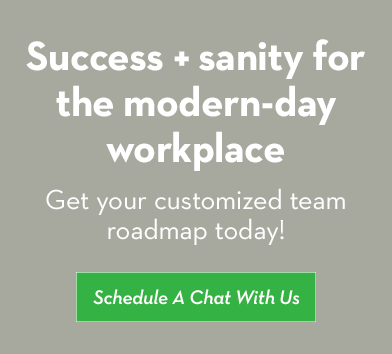Whether you call it career design, career mapping, role planning, or professional development, it is essential to map out how your people can gain the skills, experience, and expertise to grow toward a particular role, responsibility, or outcome. We call it Career Pathing.

Who Benefits from Career Pathing?
Bottom line: everyone.
Career Pathing focuses on connecting your people to the bigger picture while also identifying the tangible, day-to-day steps that lead to that vision.
If you work for a large company, you might already have a formalized annual review process. The biggest companies often will have core competencies employees are measured against. Rather than serving cross purposes, Career Pathing can actually complement your company’s existing performance review process.
For smaller companies without a baked-in formal review process, instituting a career path framework can serve the same goals.
Three Components of Career Pathing
Each person brings different skills and expertise to the table, so you can’t have one career path for everyone in the same role. But you might create a template that you adjust based on the specific employee. Regardless of the role or team member, a career path discussion involves these three things.
Articulate your desired outcomes
These are the goals to be accomplished within a set timeframe. Examples of this may be to lead a strategy presentation solo or to take over social media management.
The desired outcomes should reflect the growth of the competencies and skills the employee needs to develop. For example, if you need someone to work on communication and persuasion, give them opportunities to speak publicly, manage a meeting, lead a project, or take an improv class.
Define the skills required for the role
These skills make up the what of the job. Examples of this might be project management, public speaking, or strategic analysis.
Make sure that this discussion centers around includes outcomes and skills that excite and inspire your direct report. This is how you engage your staff. They don’t need to be inspired by everything on their plan, but they do need to have some interest and want to lean into most of it. If they don’t, then you may not have the right person for the job.
Discuss the competencies needed to succeed in the role
This is the how of the job. Some examples of core competencies are leadership, team focus, commitment to excellence, communication, and collaboration.
We have created a form to help you keep track of all this information. Download your copy..
We recommend using a 12-month time frame broken down into three-month periods. You may need to adjust midway through the year, and that’s fine. Identify the desired outcomes and required skills and competencies for each three-month window. As each window is completed, sit with your direct report and highlight wins and review any carry-overs — things that didn’t get finished or mastered. Use your own discretion to determine how much you share with your direct report. How frank you are may depend on their personality, role, level, etc.
You play an important role in the lives of those you manage. What will you do with that power?
The best part about Career Pathing is that it can make your life easier as a manager. This process formalizes your expectations and wishes along with their aspirations. It gives you blueprint for how to grow your people. And it helps everyone get on the same page. The mutual understanding that comes out of these discussions will engage and motivate your team members and will operationalize your commitment to their growth, the growth of your larger team, and the growth of the organization as a whole.
